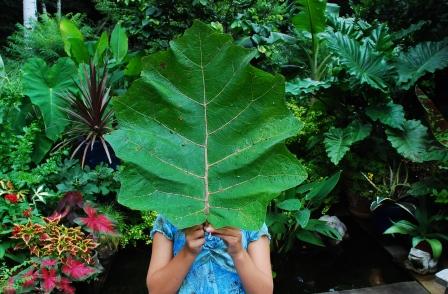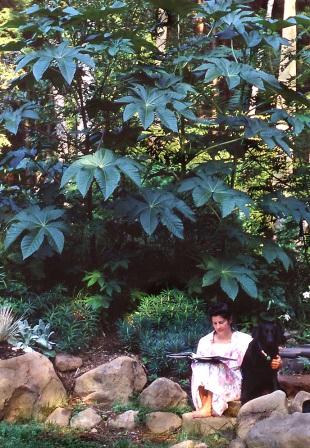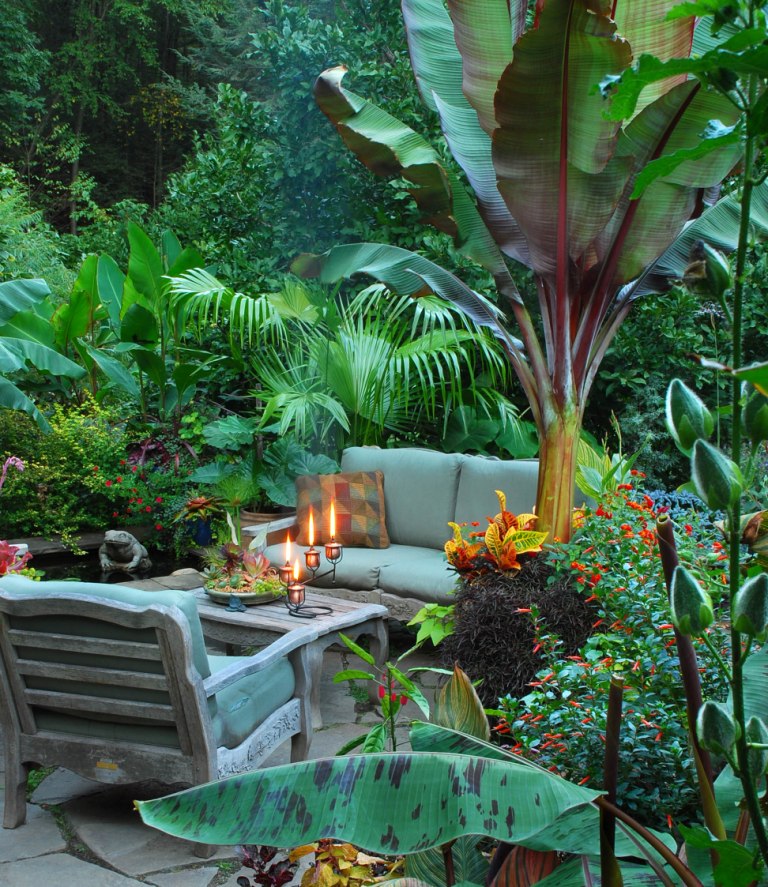Great big leaves! I love big leaves! Maybe I’m just a chlorophyll-o-phile, but as a foliage-fiend building a garden leaf by leaf, I’m forever tinkering with plant combinations based upon foliage associations. I work with contrasts and harmonies in sizes, shapes, textures–even colors. And the bigger the leaf, the more I can do with it. After all, a big leaf contrasts well with smaller ones, and the bigger the leaf, the greater the kinds of contrasts to be made. Big leaves are sometimes brazen enough to create their very own garden statement, by serving as an eye-grabbing focal point. So, I’m always on the lookout for big, bold leaves, leaves like Gulliver might have seen in his travels to Brobdingnag. All of which sort of begs the question: How big is big?
Let’s say big as a bathmat, more or less. For starters, it depends on whether we’re talking plants that are hardy or tender. Happily, there are a surprising number of plants that flaunt freakishly large foliage in both categories. For today we’ll stick with a sun-loving sampler of annuals, tropicals and tenders. We’ll bask in the shade of hardier fare in a future post. 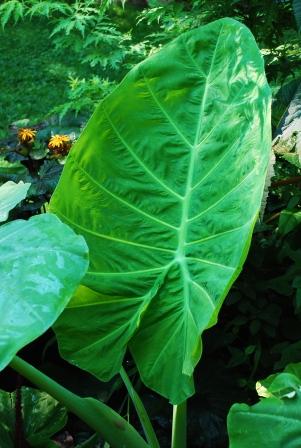
For me the undisputed colossus of chlorophyll, the king of big, the sultan of size, is Colocasia gigantea, an elephant ear so big it makes the elephant look small. (Yes, I know about gunnera, but despite my very best efforts I have been unable to grow that marvel of massiveness in my garden) Anyway, these elephant ears grow with a propulsive abandon that’s almost scary. Planted in rich soil, well fed and watered, the aptly named giant elephant ear’s new shoots leap from the ground with a speed that’s almost audible. It fires its softly rounded, leafy arrowhead up to the sky, one after another, as if to blot out the blue, but their sheer mass soon brings the leaves back toward earth. And the leaves just keep on coming, each one bigger than the last. One plant makes a season-long focal point. Heck, one plant could make a whole garden.
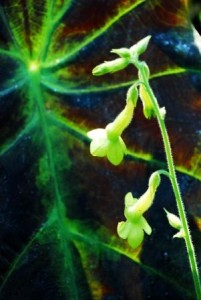 I like all the elephant ears; my current second favorite being Colocasia esculenta‘Illustris’. It’s got dark, dark leaves veined with a smeary delta of chartreuse. Like its siblings, it combines well with almost anything else. Unlike its brethren, it’s particularly suited to making fun color echoes, as with this sweet little Nicotiana whose seeds came to me from Nan, via the Mid-Atlantic Group Hardy Plant Society seed exchange.
I like all the elephant ears; my current second favorite being Colocasia esculenta‘Illustris’. It’s got dark, dark leaves veined with a smeary delta of chartreuse. Like its siblings, it combines well with almost anything else. Unlike its brethren, it’s particularly suited to making fun color echoes, as with this sweet little Nicotiana whose seeds came to me from Nan, via the Mid-Atlantic Group Hardy Plant Society seed exchange.
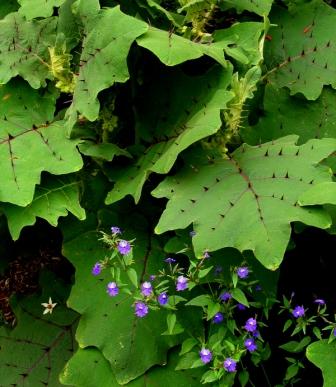 For sheer wow-power, it’s hard to beat the exquisitely weird Bed of Nails (Solanum quitoense) seen above. It’s doormat-sized leaves have edges like the reflections in a funhouse mirror, a surplus of lethal-looking thorns (on the tops and bottoms of the leaves and along the stems), and are a vaguely gray green tinged with lovely hint of purple, thanks in part to a downy fuzz–yep, it’s purplish–that carpets the leaves. Each leaf also boasts its own delta of prominent veins. It bears ping pong ball-sized fruit that ripens to a lovely orange gold and, in the tropics , is prized for the delicious juice it yields. This sun-lover is easy to start form seed (pretend you’re starting a tomato and proceed accordingly) and grows with abandon once summer heats up. A wonderful foil for softer textured annual grasses, coleus, heck almost anything.
For sheer wow-power, it’s hard to beat the exquisitely weird Bed of Nails (Solanum quitoense) seen above. It’s doormat-sized leaves have edges like the reflections in a funhouse mirror, a surplus of lethal-looking thorns (on the tops and bottoms of the leaves and along the stems), and are a vaguely gray green tinged with lovely hint of purple, thanks in part to a downy fuzz–yep, it’s purplish–that carpets the leaves. Each leaf also boasts its own delta of prominent veins. It bears ping pong ball-sized fruit that ripens to a lovely orange gold and, in the tropics , is prized for the delicious juice it yields. This sun-lover is easy to start form seed (pretend you’re starting a tomato and proceed accordingly) and grows with abandon once summer heats up. A wonderful foil for softer textured annual grasses, coleus, heck almost anything.

Another tropical fruit that makes a fine foliar statement is payaya, Carica papaya. Easy from seed, but they must be started early. Early February is when I sow mine. Once the weather heats up, they’ll take off, especially if their thirst for water and hunger for fertilizer is quenched regularly. They look great with almost anything, thanks to the wildly cut edges of their leaves. One of these years I’ll perfect a technique for overwintering these things and succeed in getting some fruit. In the meantime, the leaves will do very nicely, thank you.
Don’t try eating a castor bean (Ricinus communis). They are deadly poisonous. But what pretty poison! Their palmate leaves are the absolute personification bold beauty. Easy as pie from seed, they even self sow sometimes in my Zone 6 garden. They grow incredibly fast and are one of the few annuals that may require a chainsaw for fall clean-up. For burgundy blushed beauty, try the seed strains New Zealand Purple or one of the Carmencitas. For sheer size, grow Zanzibarensis–GIGUNDO! (above). As you might guess, all the castor beans are voracious feeders.
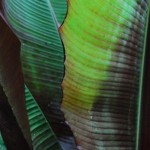 Last but by no means least, comes the banana bunch: Chinese yellow banana, Pink velvet banana, Orinoco banana, yada, yada, yada. But the most choice, for my money, is the red Abyssinian banana (Ensete ventricosum ‘Maurelii’). It’s actually not a banana, at least not botanically. Instead, it’s a first cousin–it won’t bear fruit and almost never sends up suckers. But what foliage! Its sturdy, almost leathery leaves are tough enough to avoid getting shredded by wind and rain and are colorful as all get out-blushed with deepest burgundy. They’re massive too. I’ve had leaves about five feet long and two feet wide. Lastly there’s the burgundy-almost ebony-hue of the trunk, which I am careful to expose by trimming any floppy foliage at the very base of the tree. In the ground, in pot–put these anywhere and admire the show. Don’t forget to pour on the water and the fertilizer. I overwinter mine in a cool dark basement and after a few years get a fine-sized specimen.
Last but by no means least, comes the banana bunch: Chinese yellow banana, Pink velvet banana, Orinoco banana, yada, yada, yada. But the most choice, for my money, is the red Abyssinian banana (Ensete ventricosum ‘Maurelii’). It’s actually not a banana, at least not botanically. Instead, it’s a first cousin–it won’t bear fruit and almost never sends up suckers. But what foliage! Its sturdy, almost leathery leaves are tough enough to avoid getting shredded by wind and rain and are colorful as all get out-blushed with deepest burgundy. They’re massive too. I’ve had leaves about five feet long and two feet wide. Lastly there’s the burgundy-almost ebony-hue of the trunk, which I am careful to expose by trimming any floppy foliage at the very base of the tree. In the ground, in pot–put these anywhere and admire the show. Don’t forget to pour on the water and the fertilizer. I overwinter mine in a cool dark basement and after a few years get a fine-sized specimen.

